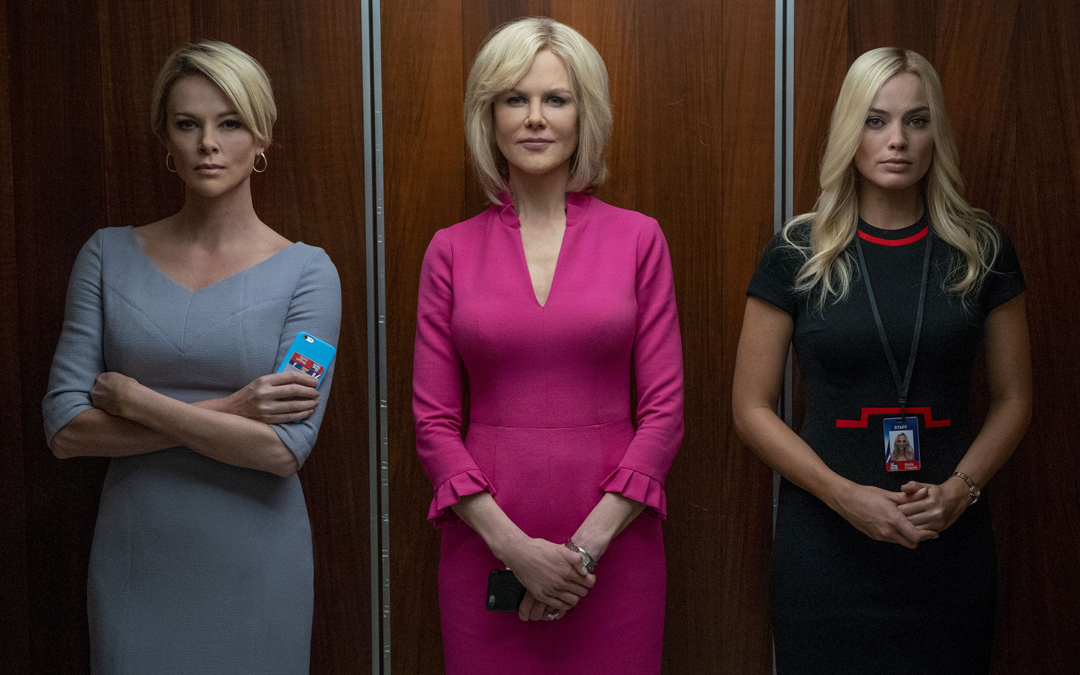All The Write Moves: Bombshell
December 9, 2019
Just months after Showtime aired The Loudest Voice, a miniseries about the late Roger Ailes’ controversial career as chairman of Fox News, theatrical feature Bombshell explores a nearly identical subject matter, albeit in a more truncated fashion. This raises the obvious questions of whether there’s enough story in Ailes’ life to justify this much screentime, and whether Bombshell adds something new to the conversation. The answer to both questions, is yes.
Ailes earned his greatest notoriety by developing Fox News as a vessel for conservative politics, blending techniques from entertainment, journalism and propaganda to create a 24/7 outrage machine. His advocates praised Ailes for giving those on the right side of the American political spectrum a voice, while his critics vilified Ailes for giving signal boosts to conspiracy theories and hate speech. It is generally accepted that Ailes’ ultimate victory was Donald Trump’s presidential election, because Fox relentlessly advocated for Trump candidacy.
Given this context, it’s convenient to assume that “liberal Hollywood” has doubled down on Ailes stories as a means of skewering people in Trump’s orbit. After all, Ailes lost his Fox job because of credible sexual assault allegations, a crime of which Trump himself has been repeatedly accused. But, as both The Loudest Voice and Bombshell dramatize, there’s more to the Ailes story than Ailes himself, or even Ailes’ close association with Trump. What both narratives investigate is the question of why so many people helped Ailes disseminate incendiary content, and why such a wide swath of the public embraced the content. Ailes had a profound influence on American life, the effects of which are still being felt two years after his death.
Whether Bombshell adds something new to the conversation, the answer is: Megyn Kelly. Despite her central role in the Ailes/Trump melodrama that generated endless headlines during the 2016 election, Kelly was not depicted in The Loudest Voice, but she is the main character of Bombshell.
He Said, She Said
Screenwriter Charles Randolph, who won an Oscar for co-writing 2015’s The Big Short with Adam McKay, based his original screenplay for Bombshell on extensive interviews and research. Arguably his most important storytelling choice was to center the film around women, with Kelly (played by Charlize Theron) situated as the first among equals, even though Gretchen Carlson (Nicole Kidman) and the fictional character of Kayla Pospisil (Margot Robbie) are also crucial to the narrative. This storytelling choice grounds Bombshell in a fundamentally different perspective than the one expressed by The Loudest Voice: the one of Ailes’ victims.
This storytelling choice elevates Bombshell above mere party politics by engaging with an even more controversial subject—the #MeToo movement. It is giving nothing away to reveal that all three main characters in Bombshell experience harassment by Ailes (John Lithgow). Each woman reacts differently
Carlson tolerates demeaning behavior until it crosses a line, at which point she retains counsel and spends a year secretly tape-recording Ailes as preparation for inevitable legal action. Kelly refuses an overt sexual overture, filing the incident away in her memory until years later, when her choice of whether to publicly acknowledge what happened becomes consequential. Pospisil, the character with the least amount of leverage in the Fox News organization, follows a more traumatizing path than Carlson or Kelly.
By depicting these divergent experiences, and the fraught sociopolitical climate in which the experiences occur, Randolph creates a complicated portrait. At various points in the movie, Carlson, Kelly and Pospisil each wrestle with the difficult issue of complicity. For Carlson and Kelly, who became Fox News stars despite their run-ins with Ailes, the relevant question is why they didn’t use their power to speak out, thus preventing future abuse. Pospisil, meanwhile, must contemplate the cost of compromising principles in the name of career advancement. Investigating these topics allows Randolph to address one of the most insidious aspects of sexual abuse—the awful tendency of victims to blame themselves instead of their abusers.
Takeaway: Viewing a familiar story through an unfamiliar perspective is an effective technique for uncovering fresh themes.
Fear Factor
Throughout Bombshell, Ailes is depicted as a paranoid control freak with serious anger-management issues. Whereas the makers of The Loudest Voice offered a more dimensional portrayal, showing an Ailes who was capable of charm and generosity, Randolph and his Bombshell collaborators mostly focus on Ailes’ toxic qualities. The clear impression gets put across that Ailes formed Fox News in his own image, up to and including disdain for other media sources. “News is like a ship,” Ailes says in Bombshell. “Take your hands off the wheel, it tilts hard to the left.”
A deeply held political viewpoint is one thing, but a myopic perspective informed by dark fantasies is quite another. In Bombshell, Ailes personifies hypocrisy because at the same time he grossly abuses his power by manipulating women he finds sexually attractive, he complains whenever he perceives that someone else is using their power against him. Randolph implies that this aspect of Ailes’ personality helps explain the man’s affinity for conspiracy theories—since Ailes is always working the angles for his own benefit, he presumes that everyone else approaches life in just as craven a manner.
During one memorable sequence, Kelly falls ill before co-moderating a presidential debate. Because this happens while Kelly is caught in a public battle with candidate Trump, Ailes suggests to Kelly that Trump might have arranged to poison Kelly. Setting aside the weird implications of Ailes accusing a personal friend and political ally of a crime, this moment leads to Ailes articulating his profoundly cynical outlook. Kelly opines that the poisoning theory is “crazy.” Ailes’ reply: “It’s only crazy till it happens.”
Portraying unsympathetic characters as paranoid can be a lazy shortcut, but in this case, Randolph based the character trait on extensive research. So instead of merely expressing that Ailes sees the world in terms of me-vs.-them, Randolph suggests something deeper. He implies that Ailes’ use of fear as a propaganda tool is a self-fulfilling prophecy. Did Ailes see enemies everywhere before he built a network designed to convince Republicans they have enemies everywhere, or vice versa? The question is unanswerable, but it’s unnerving to contemplate.
Takeaway: Showing what frightens a character provides fascinating insights.
Eyes of the Beholder
Replicating some of the experiments that Randolph and McKay used for The Big Short, Randolph employs a number of unexpected techniques in Bombshell. Characters break the fourth wall, narration reveals characters’ inner thoughts, and so on. But perhaps the boldest technique in Bombshell involves the wholesale fabrication of a major character within an otherwise fact-based storyline. Given that Randolph had so much real material to work with, why bother inventing Kayla Pospisil?
She serves a number of helpful narrative functions. As mentioned, she is the most powerless Ailes victim in the movie. She also idolizes Carlson and Kelly, since Pospisil aspires to become an on-air personality at Fox News. But most importantly, she is portrayed as someone who loved Fox News from the outside before finding her way in. She is the channel’s audience personified.
Randolph sets up that Pospisil comes from a Fox News-loving household, and that her sociopolitical ideology overlaps with the channel’s bias. She loves the church and the Republican party, not necessarily in that order. When Pospisil arrives at Fox News full of ambition and enthusiasm, she believes that advancing her career is also a means of honoring her belief system. Therefore, once Pospisil discovers that Ailes uses his power to gain sexual favors, the discovery rattles her deeply. She’s not just disappointed in an individual—she’s disappointed in an institution.
Seen in this light, the foremost utility of the Pospisil character is that she provides the blank-slate perspective of the audience, which is such a classic screenwriting technique that it’s a staple of most features and TV shows about workplaces. By definition, a newcomer enters a workplace unaware of hidden agendas and office politics, so the process of learning about those things provides a natural arc. Upon learning that a workplace is toxic, does the newcomer try to force change from within, or does the newcomer flee? As Bombshell demonstrates, the resolution of that dilemma can be the springboard for a satisfying ending.
Takeaway: The unvarnished viewpoint of a newly arrived character is a helpful device when telling a story about a complicated institution.
Written by: Peter Hanson
Peter Hanson is a Los Angeles-based writer, filmmaker and teacher. He directed the screenwriting documentary Tales from the Script, and he teaches at Pepperdine University and UCLA Extension. He provides script consulting at www.GrandRiverFilms.com.- Topics:
- Discussing TV & Film




